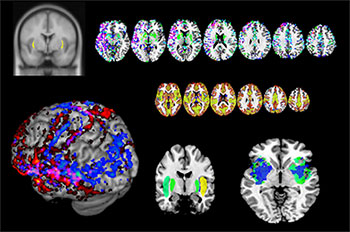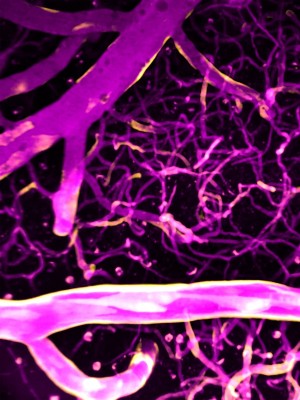November 14, 2022 | Vanessa McMains
 The Brain’s Claustrum, Receives, Amplifies, and Broadcasts an ‘Internet Network’ Required to Complete Complex Cognitive Tasks
The Brain’s Claustrum, Receives, Amplifies, and Broadcasts an ‘Internet Network’ Required to Complete Complex Cognitive Tasks
Tucked underneath the brain’s outer, wrinkly cortex is a deeply mysterious area, known as the claustrum. This region has long been known to exchange signals with much of the cortex, which is responsible for higher reasoning and complex thought. Because of the claustrum’s extensive connections, the legendary scientist Francis Crick, PhD, of DNA-discovery fame, first postulated in 2005 that the claustrum is the seat of consciousness. In other words, the region of the brain enabling awareness of the world and ourselves.
Researchers at the University of Maryland School of Medicine (UMSOM), however, now posit that Crick may have been incorrect: They developed a new theory — built on data — that the claustrum behaves more like a high-speed internet router, taking in executive commands from “boss” areas of the brain’s cortex that forms complex thoughts to generate “networks” in the cortex. Acting like a router, the claustrum coordinates these networks to work together to accomplish the many different cognitively demanding tasks we perform on a moment-to-moment basis in everyday life.
Understanding how the brain forms and coordinates these networks in the cortex through the claustrum is important, since disorganized networks are a typical feature across many disorders, such as addiction, Alzheimer’s disease, and schizophrenia. This insight may help lead to better therapies to address cognitive dysfunction in these disorders.
 “The brain is the most complex system in the known universe. It is these data-driven theoretical advances that propel our knowledge forward toward harnessing that complexity for improving human life,” said Brian Mathur, PhD, Associate Professor of Pharmacology at UMSOM. “As the most highly connected structure in the brain, the claustrum is a window into the enigma of the brain, the mind.”
“The brain is the most complex system in the known universe. It is these data-driven theoretical advances that propel our knowledge forward toward harnessing that complexity for improving human life,” said Brian Mathur, PhD, Associate Professor of Pharmacology at UMSOM. “As the most highly connected structure in the brain, the claustrum is a window into the enigma of the brain, the mind.”
Their new findings and hypothesis were published on Sept. 30, 2022, in Trends In Cognitive Sciences.
In an effort to identify the precise role of the claustrum, Dr. Mathur and his colleagues conducted a serious of experiments on both animals and people. One experiment used modern neuroscience approaches to turn off the claustrum in conscious mice. These mice didn’t lose consciousness and kept running around normally. One strike against Crick’s theory!
 Next, the researchers gave mice a cognitively simple or a difficult task and compared how they responded when the claustrum was turned off. Normally, a mouse can perform both the simple and the difficult tasks. Yet, when the researchers turned off the claustrum, the mice could no longer perform the difficult task.
Next, the researchers gave mice a cognitively simple or a difficult task and compared how they responded when the claustrum was turned off. Normally, a mouse can perform both the simple and the difficult tasks. Yet, when the researchers turned off the claustrum, the mice could no longer perform the difficult task.
Wondering if this finding had any relevance to humans, Dr. Mathur collaborated with his colleagues David Seminowicz, PhD, Professor of Neural and Pain Sciences at the UM School of Dentistry, and Fred Barrett, PhD, Associate Professor of Psychiatry and Behavioral Sciences at Johns Hopkins University School of Medicine. The three organized a research study where they conducted functional MRI brain scans on healthy volunteers who were engaged in either simple or complicated mental tasks. The researchers observed that their claustrum only “lit up” when performing the difficult version of the task. This event coincided with the activation of a network in the cortex involved in optimal cognitive performance. Strike two against Crick’s consciousness theory!
 Dr. Mathur said that strike three will be when additional experiments support their theory of claustrum function. In doing so, Dr. Mathur and his colleagues now seek to understand how the claustrum learns and adapts to orchestrate networks in the cortex to help support cognition.
Dr. Mathur said that strike three will be when additional experiments support their theory of claustrum function. In doing so, Dr. Mathur and his colleagues now seek to understand how the claustrum learns and adapts to orchestrate networks in the cortex to help support cognition.
“Understanding how the brain flexibly forms and coordinates these networks — through the claustrum — is essential to treat cognitive decline, which happens in addiction, Alzheimer’s disease, and schizophrenia,” said UMSOM Dean Mark T. Gladwin, MD, who is also Vice President for Medical Affairs, University of Maryland, Baltimore, and the John Z. and Akiko K. Bowers Distinguished Professor.
Dr. Mathur added, “Our hypothesis provides us with a much-needed conceptual framework to devise new therapeutic strategies.”
The study was funded by the NIH’s National Institute on Alcohol Abuse and Alcoholism (grant R01AA028070).
Dr. Barrett is on the scientific advisory board for Wavepaths, Ltd. and a scientific advisor for Mindstate Design Labs, Inc.
For More Information
About the University of Maryland School of Medicine
Now in its third century, the University of Maryland School of Medicine was chartered in 1807 as the first public medical school in the United States. It continues today as one of the fastest growing, top-tier biomedical research enterprises in the world — with 46 academic departments, centers, institutes, and programs, and a faculty of more than 3,000 physicians, scientists, and allied health professionals, including members of the National Academy of Medicine and the National Academy of Sciences, and a distinguished two-time winner of the Albert E. Lasker Award in Medical Research. With an operating budget of more than $1.3 billion, the School of Medicine works closely in partnership with the University of Maryland Medical Center and Medical System to provide research-intensive, academic, and clinically based care for nearly 2 million patients each year. The School of Medicine has nearly $600 million in extramural funding, with most of its academic departments highly ranked among all medical schools in the nation in research funding. As one of the seven professional schools that make up the University of Maryland, Baltimore campus, the School of Medicine has a total population of nearly 9,000 faculty and staff, including 2,500 students, trainees, residents, and fellows. The combined School of Medicine and Medical System (“University of Maryland Medicine”) has an annual budget of over $6 billion and an economic impact of nearly $20 billion on the state and local community. The School of Medicine, which ranks as the 8th highest among public medical schools in research productivity (according to the Association of American Medical Colleges profile) is an innovator in translational medicine, with 606 active patents and 52 start-up companies. In the latest U.S. News & World Report ranking of the Best Medical Schools, published in 2021, the UM School of Medicine is ranked #9 among the 92 public medical schools in the U.S., and in the top 15 percent (#27) of all 192 public and private U.S. medical schools. The School of Medicine works locally, nationally, and globally, with research and treatment facilities in 36 countries around the world. Visit medschool.umaryland.edu
Contact
Vanessa McMains
Director, Media & Public Affairs
University of Maryland School of Medicine
Institute of Human Virology
vmcmains@ihv.umaryland.edu
Cell: 443-875-6099
Related stories

Wednesday, April 02, 2025
Researchers Reveal Key Brain Differences to Explain Why Ritalin Helps Improve Focus in Some More Than Others
Nearly 16 million American adults have been diagnosed with attention deficit hyperactivity disorder (ADHD), but evidence suggests that more than 30 percent of them don’t respond well to stimulant medications like Ritalin and Adderall. A new clinical trial provides a surprising explanation for why this may be the case: There are individual differences in how our brains circuits are wired, including the chemical circuits responsible for memory and concentration, according to a new study co-led by the University of Maryland School of Medicine (UMSOM) and performed at the National Institutes of Health (NIH) Clinical Center.

Tuesday, October 22, 2024
UM School of Medicine's Margaret M. McCarthy, PhD, Elected as Member of Prestigious National Academy of Medicine
Margaret M. McCarthy, PhD, an internationally-recognized neuroscientist, who is the James and Carolyn Frenkil Dean’s Endowed Professor in the University of Maryland School of Medicine's Department of Pharmacology, Physiology, and Drug Development, and Director of the University of Maryland – Medicine Institute of Neuroscience Discovery (UM-MIND), has been elected as a new member of the National Academy of Medicine.

Tuesday, April 25, 2023
Immune System Sculpts Rat Brains During Development
Researchers have established that biological sex plays a role in determining an individual’s risk of brain disorders. For example, boys are more likely to be diagnosed with behavioral conditions like autism or attention deficit disorder, whereas women are more likely to suffer from anxiety disorders, depression, or migraines. However, experts do not fully understand how sex contributes to brain development, particularly in the context of these diseases. They think, in part, it may have something to do with the differing sizes of certain brain regions.

Friday, March 31, 2023
Traumatic Brain Injury Interferes with Immune System Cells’ Recycling Process in Brain Cells
Each year about 1.5 million people in the U.S. survive a traumatic brain injury due to a fall, car accident, or a sports injury, which can cause immediate and long-term disability.

Friday, January 06, 2023
UM School of Medicine Scientists Create First Extensive Brain Cell Data Repository
Neuroscience researchers now have access to 50 million brain cells to better understand how the brain develops and functions or changes with disease or trauma. Last month, scientists at the University of Maryland School of Medicine’s (UMSOM) Institute for Genome Sciences (IGS) unveiled a “one-stop shop” for brain cell data called the Neuroscience Multi-Omic Archive (NeMO Archive). This archive is now available to neuroscience researchers to transform their understanding of the complex workings of the brain.

Monday, March 14, 2022
Dancing Laboratory Rats Show How the Brain Learns, Perfects, then Unconsciously Performs a Skillful Movement
Learning a complex skilled movement like tying your shoes or playing an instrument takes practice. After repeating the same movements over and over, people often develop a formulaic way of performing the task, and may not even have to think about it anymore. Although we accomplish such repetitive tasks every day, little is known about how the brain learns, repeats, and perfects them.

Thursday, January 27, 2022
Microbiome of Mother’s Vagina May Affect Infant Mortality Risk and Baby’s Development
A new study in mice from University of Maryland School of Medicine researchers showed that an unhealthy vaginal microbiome in pregnant mothers in combination with an unhealthy diet contributed to increased pup deaths and altered development in the surviving babies.

Wednesday, July 21, 2021
University of Maryland School of Medicine Study Finds Calcium Precisely Directs Blood Flow in the Brain
University of Maryland School of Medicine and University of Vermont researchers have shown how the brain communicates to blood vessels when in need of energy, and how these blood vessels respond by relaxing or constricting to direct blood flow to specific brain regions.

Wednesday, September 25, 2019
Dr. Tracy Bale Elected President of the International Brain Research Organization
Tracy L. Bale, PhD, Professor of Pharmacology and Director of the Center for Epigentic Research in Child Health & Brain Development has been elected President of the International Brain Research Organization.

Monday, April 29, 2019
UMSOM’s Reading on the Brain Program Teaches Baltimore City Elementary Students About the Brain-Building Power of Reading
Acting Baltimore City Mayor Jack Young joined 4th and 5th grade students at Callaway Elementary School to help paint a mural about the brain. It was all part of Reading on the Brain, a University of Maryland School of Medicine (UMSOM) program to teach young students about the importance of reading and how reading can stimulate brain development and inspire future success. Tracy Bale, PhD, is leading the pilot program, which also emphasizes science and helps children to understand how the brain works.

Thursday, March 28, 2019
Allergic Reactions Play Role in Sexual Behavior Development in Unborn Males and Females, UMSOM Research Shows
Researchers at the University of Maryland School of Medicine and colleagues at Ohio State University have discovered that allergic reactions trigger changes in brain behavior development in unborn males and females. This latest brain development discovery will ultimately help researchers better understand how neurological conditions can differ between men and women.

Friday, March 01, 2019
UMSOM Researchers Discover Clues to Brain Differences Between Males and Females
Researchers at the University of Maryland School of Medicine have discovered a mechanism for how androgens -- male sex steroids -- sculpt brain development. The research, conducted by Margaret M. McCarthy, Ph.D., Professor of Pharmacology and Chair of the Department of Pharmacology, could ultimately help researchers understand behavioral development differences between males and females.

Tuesday, September 11, 2018
New Study Finds Unexpected Link Between Immune Cells and Male/Female Differences
Researchers at the University of Maryland School of Medicine (UMSOM) have made a surprising discovery: during fetal development, a particular immune cell seems to play a key role in determining the male or female characteristics of the brain.

Thursday, December 07, 2017
University of Maryland School of Medicine Scientists Identify the First Brain Cells to Respond to Sound
Some expectant parents play classical music for their unborn babies, hoping to boost their children’s cognitive capacity. While some research supports a link between prenatal sound exposure and improved brain function, scientists had not identified any structures responsible for this link in the developing brain.

